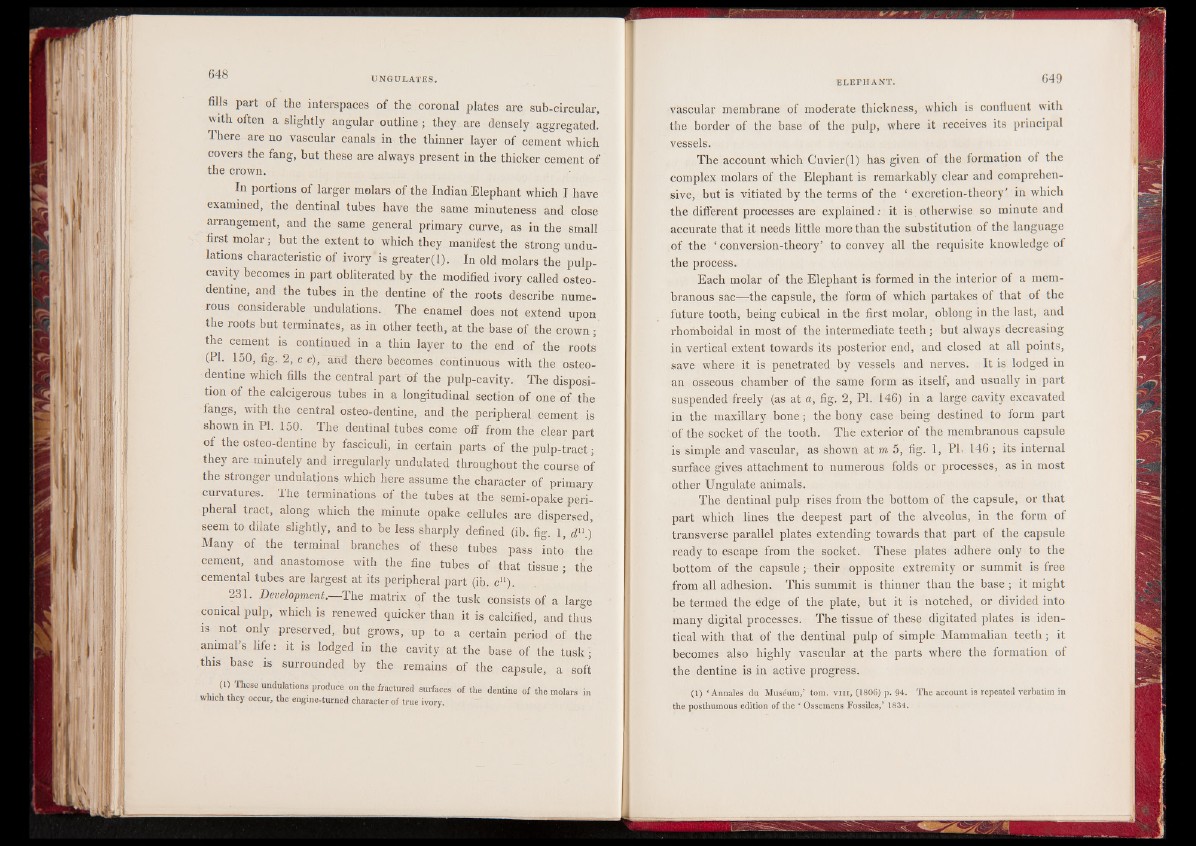
fills part of the interspaces of the coronal plates are sub-circular,
with often a slightly angular outline; they are densely aggregated.
There are no vascular canals in the thinner layer of cement which
covers the fang, but these are always present in the thicker cement of
the crown.
In portions of larger molars of the Indian Elephant which I have
examined, the dentinal tubes have the same minuteness and close
arrangement, and the same general primary curve, as in the small
first molar | but the extent to which they manifest the strong undulations
characteristic of ivory‘is greater(l). In old molars the pulp-
cavity becomes in part obliterated by the modified ivory called osteo-
dentine, and the tubes in the dentine of the roots describe numerous
considerable undulations. The enamel does not extend upon
the roots but terminates, as in other teeth, at the base of the crown;
the cement is continued in a thin layer to the end of the roots
(PI. 150, fig. 2, c c), and there becomes continuous with the osteo-
dentine which fills the central part of the pulp-cavity. The disposition
of the calcigerous tubes in a longitudinal section of one of the
fangs, with the central osteo-dentine, and the peripheral cement is
shown in PL 150. The dentinal tubes come off from the clear part
of the osteo-dentine by fasciculi, in certain parts of the pulp-tract;
they are minutely and irregularly undulated throughout the course of
the stronger undulations which here assume the character of primary
curvatures. The terminations of the tubes at the semi-opake peripheral
tract, along which the minute opake cellules are dispersed,
seem to dilate slightly, and to be less sharply defined (ib. fig. 1 , dn )
Many of the terminal branches of these tubes pass into the
cement, and anastomose with the fine tubes of that tissue; the
cemental tubes are largest at its peripheral part (ib. c11}.
231. Development.—The matrix of the tusk consists of a large
conical pulp, which is renewed quicker than it is calcified, and thus
is not only preserved, but grows, up to a certain period of the
animal’s life: it is lodged in the cavity at the base of the tusk;
this base is surrounded by the remains of the capsule, a soft
(1) These undulations produce on the fractured surfaces of the dentine of the molars in
which they occur, the engine-turned character of true ivory.
vascular membrane of moderate thickness, which is confluent with
the border of the base of the pulp, where it receives its principal
vessels.
The account which Cuvier(l) has given of the formation of the
complex molars of the Elephant is remarkably clear and comprehensive,
but is vitiated by the terms of the ‘ excretion-theory’ in which
the different processes are explained: it is otherwise so minute and
accurate that it needs little more than the substitution of the language
of the ‘ conversion-theory’ to convey all the requisite knowledge of
the process.
Each molar of the Elephant is formed in the interior of a membranous
sac—the capsule, the form of which partakes of that of the
future tooth, being cubical in the first molar, oblong in the last, and
rhothboidal in most of the intermediate teeth ; but always decreasing
in vertical extent towards its posterior end, and closed at all points,
save where it is penetrated by vessels and nerves. It is lodged in
an osseous chamber of the same form as itself, and usually in part
suspended freely (as at a, fig. 2, PI. i46) in a large cavity excavated
in the maxillary bone; the bony case being destined to form part
of the socket of the tooth. Thé exterior of the membranous capsule
is simple and vascular, as shown at m 5, fig. 1, PL 146; its internal
surface gives attachment to numerous folds or processes, as in most
other Ungulate animals.
The dentinal pulp rises from the bottom of the capsule, or that
part which lines the deepest part of the alveolus, in the form of
transverse parallel plates extending towards that part of the capsule
ready to escape from the socket. These plates adhere only to the
bottom of the capsule;- their opposite extremity or summit is free
from all adhesion. This summit is thinner than the base ; it might
be termed the edge of the plate, but it is notched, or divided into
many digital processes. The tissue of these digitated plates is identical
with that of the dentinal pulp of simple Mammalian teeth; it
becomes also highly vascular at the parts where the formation of
the dentine is in active progress.
(1) ‘ Annales du Muséum/ tom. vm , (1806) p. 94. The account is repeated verbatim in
the posthumous edition of the ‘ Ossemens Fossiles/ 1834.